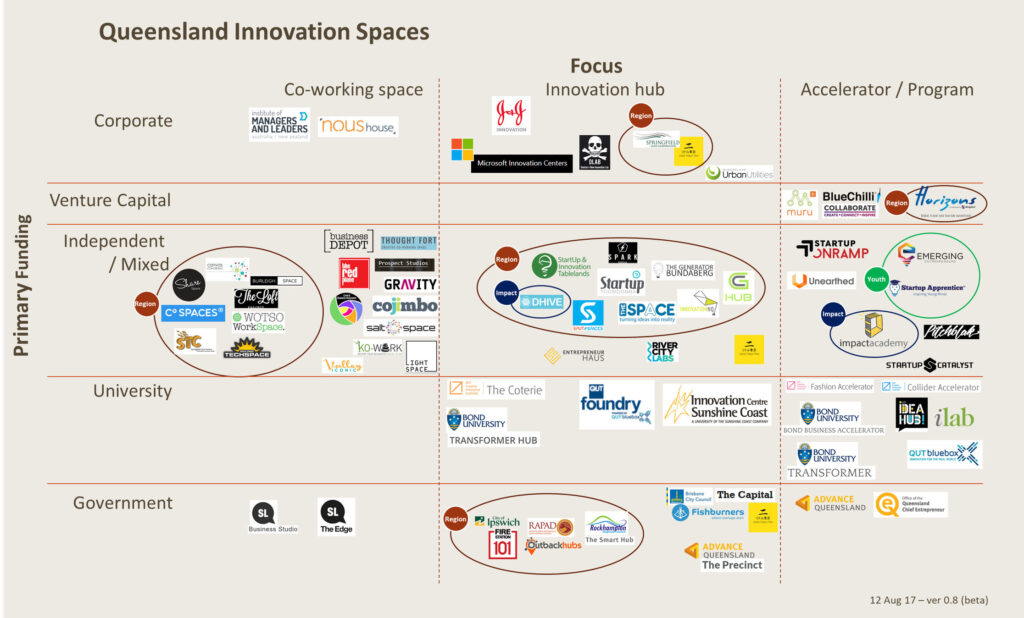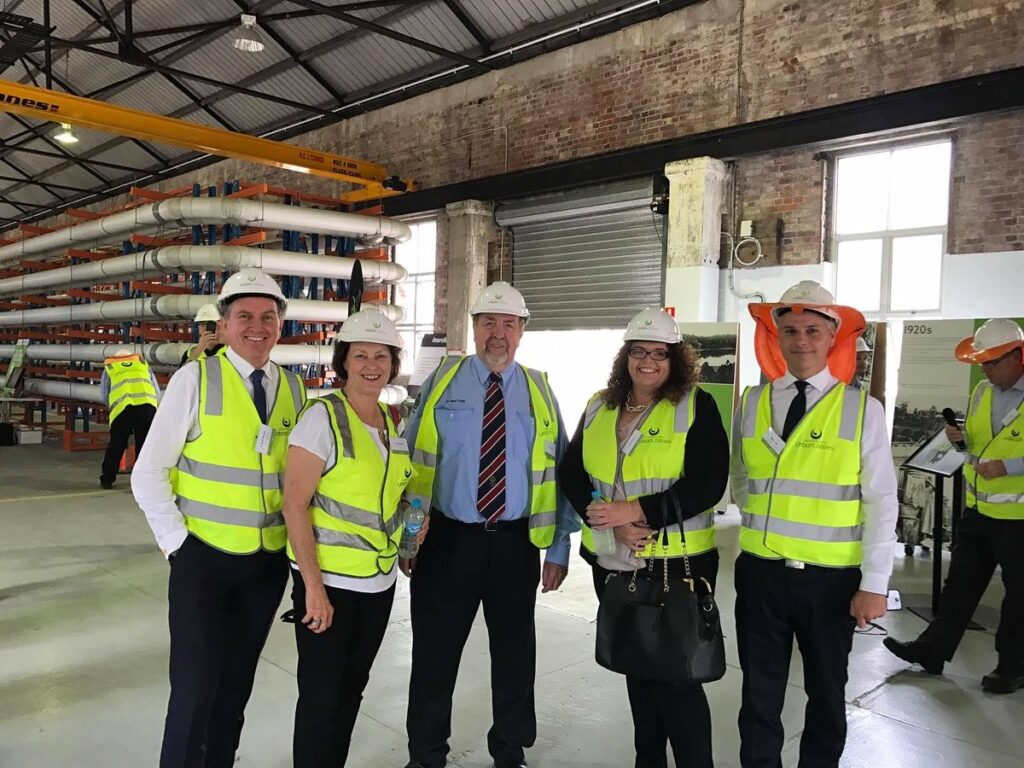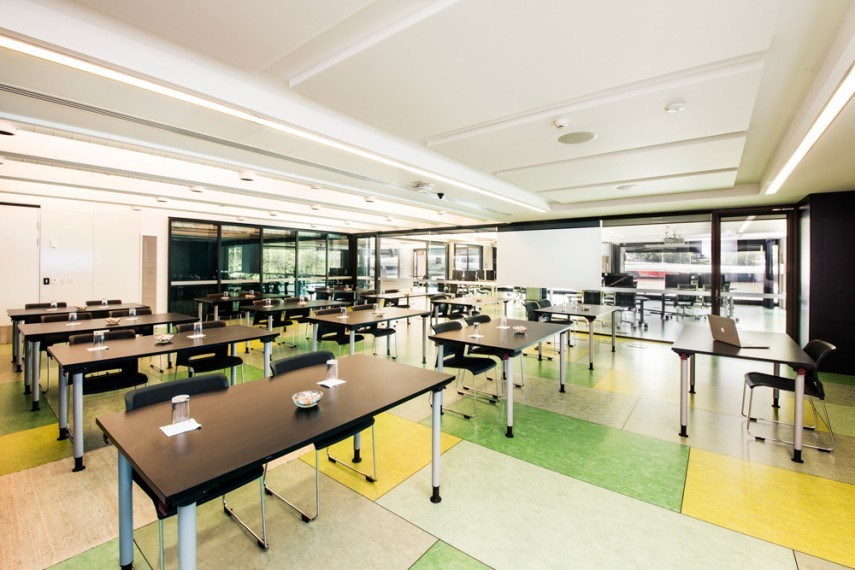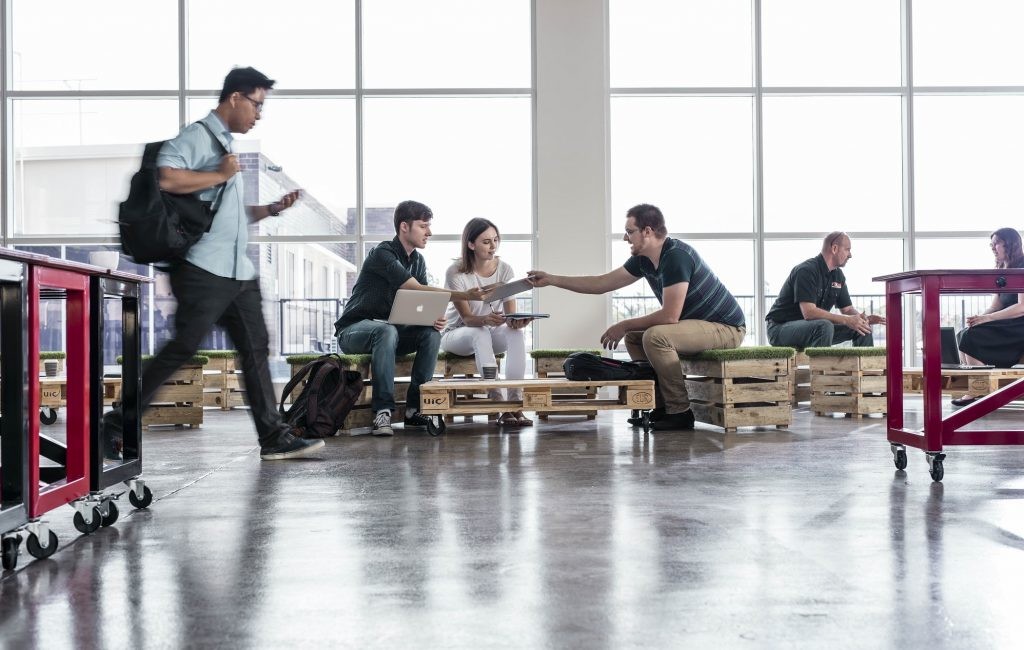Models of innovation spaces: A map of Queensland’s accelerators, innovation hubs, and co-working spaces
The role of innovation hubs in innovation ecosystems
The concept of an “ecosystem” in relation to innovation is becoming more understood, and refers to the configuration of government policy and programs, investment groups, corporations, education providers, and service providers focused on entrepreneurial activity.
Physical spaces play a key role in the innovation ecosystem. Physical spaces bring the different parts of the ecosystem together in what can be considered a non-partisan “third space”. A third space is a place that is not home or work, but a safe place where community emerges around shared interests. Like a church for faith and religion or a soccer field for sport and family, the innovation hub is common ground for developing and scaling ideas.
The hub acts as an innovation engine for a region or sector, taking inputs of market demands and local needs and transforming them through programs, culture, and chance encounters into scalable outcomes.
A taxonomy of innovation hubs in Queensland
Each space is different. Part of my current line of research for my PhD as well as measuring the ecosystem in Queensland is identifying how these differences impact outcomes for entrepreneurs and regional ecosystems.
An observation from my recent North American tour of mature and emerging ecosystems was the specialisation and diversity within spaces and programs. This specialisation creates a taxonomy based on the sector, geography, impact, business model, stage, and demographic focus of the space.
Two main characteristics form the business model of the innovation hub. First is the owner or primary funding agent driving the agenda for the space (Corporate, VC, Independent / Mixed, University, and Government). This agenda will define the programming, leadership style, and the overall entrepreneur experience in the hub.
For the purpose of the model, multi-site brands such as Little Tokyo Two and Fishburners are positioned based on the funding model that supports their operation. This is distinct from company structure such as for profit or not for profit, and means a single brand can be positioned in multiple areas under different models.
The second business model characteristic is the degree of focus on entrepreneurial activity. This ranges from primary desk-for-hire co-working, through to innovation hubs with specialist programming and events, and on to structured accelerator / incubator programs. The greater the emphasis on entrepreneurial activity, the greater the reliance on additional revenue streams to support resources for related events, programs, and investment.
In addition to these two characteristics, other attributes that differentiate spaces include whether a space is regional, has a specific focus on social outcomes, is targeted at youth, the sector focus (health, tourism, defence, etc.), whether a hardware / hackerspace element is offered, and stage (early, seed, scale-up).
The spaces listed below are based on spaces I am aware of, Google search, and the recent website launch of the Queensland Office of the Chief Entrepreneur which provides a great first pass at a searchable map of Queensland’s innovation ecosystem.
Some spaces may be missing, and others may not be active. I have personally engaged with many of the spaces or groups on the list, but not all. I have done my best to not misrepresent. Drop me a line if you know a space or program that needs to be included or if you feel your space needs to be adjusted in the list.
- Ver 0.1: Initial release
- Ver 0.2: Add University QUT Fashion Accelerator, Community Unearthed Accelerator.
- Ver 0.3: Add University QUT Collider Accelerator
- Ver 0.4: Update to include headings “Primary Funding” “Focus”
- Ver 0.5: Add Government Innovation Hub Rockhampton’s The Smart Hub
- Ver 0.6: Add Corporate Innovation Hub J&J Innovation at QUT
- Ver 0.7: Change primary funding category from “Community” to “Independent / Mixed”. Add Independent Co-working Space Central Business Associations in Wynnum and Bond University Transformer as a University Innovation Hub and Program
- Ver 0.8: Update name of VC Slingshot Program Horizons in Cairns, Add Independent program Pitchblak

Corporate
Corporate models are funded by a single corporation or association that has an objective not specifically to manage spaces. Corporations get the benefit of access to new technology and ideas, support for commercialisation of R&D products, and exposing staff to new ideas and mentoring opportunities.
Market disruptions and the rapid pace of technology and corresponding competitive threats drive companies to invest in open innovation opportunities. Companies and entire industries are challenged to be what is referred to as “ambidextrous”, exploring new opportunities while simultaneously continuing to exploit core strengths and assets.
Corporate engagement is growing in Australia, but appears more mature in overseas markets. Similar to criticism in other management movements such as “white-washing” for unsubstantiated corporate social responsibility and “green-washing” for lack of environmental commitment, companies need consistent and real investment to avoid accusations of performing “innovation theatre” to get the real benefit of innovation investment.
Spaces included in this list need to be part of the “open” innovation framework, meaning they are open to customers, supply chains, and/or public. Spaces for internal staff only may make great internal R&D departments and are a safer governance play but will not gain the benefits from boundary spanning activities and diversity of perspectives.
Corporate co-working

Image: Nous Group LinkedIn
Corporate co-working models provide opportunities to work along side professionals in a given discipline. Managing a space without an innovation outcome is usually driven by business development activities for new clients or a value-added or premium offering for current clients or members.
Nous House is an interesting model, providing a co-working space alongside professional consultants. From working in a similar consultancy, I am keen to see the model replicated among other Tier one and Tier two consultancies.
The Institute of Manager and Leaders offers co-working space across Australia for members. Having worked on a startup with other professionals meeting in hotel lobbies in the CBD, this is a good value add for traveller and professional ad hoc working space.
Corporate innovation hubs

Image: Queensland Urban Utilities Innovation Lab, Luggage Point (Ipswich City Council – Cr David Morrison, Cr Shelia Ireland, Cr Paul Tully, Cr Kerry Silver; Queensland Urban Utilities – Mark Letica)
Corporate innovation hubs provide an opportunity to access specialist talent and leverage global supply chains and networks. Investment by the companies in the form of full ownership to subsidised rent means they can influence the desired outcomes of entrepreneurs in the space. Some spaces exist simply to showcase or access the corporation’s technology (Domino’s, Microsoft), others drive community outcomes (Springfield Land Corporation), and the J&J Innovation Lab at QUT offers co-working, and education, training and networking events.
- The Brisbane Microsoft Innovation Centre is a good opportunity particularly for startups leveraging the Microsoft technology stack.
- Domino’s DLab launched last year and little has been written about since but I expect everything coming out of there will taste like pizza.
- Springfield Land Corporation partnered with Little Tokyo Two to develop entrepreneurial activity in Springfield.
- J&J Innovation Centre at QUT offers co-working and provides access to knowledge exchange, scouting programs, and scientific, regulatory and commercialisation expertise for academics, entrepreneurs and other early-stage innovators.
- Queensland Urban Utilities innovation lab at Luggage Point is a space that showcases technical demonstrations for all things treatment and water management.
Venture Capital

Image: muru-D second cohort out of River City Labs (The Tech Street Journal)
Venture capital models are funded by multiple companies or private investors who share desired outcomes such as technology development or simply a return on investment. The Queensland Venture Capital model has not yet evolved into having dedicated innovation hub spaces for the VC program, such as you see with 500 Startups or TechStars who have dedicated spaces in other markets. We do see partnering with established spaces, such as “River City Labs powered by muru-D”.
The VC model is typically focused on the exit of the entrepreneur. This emphasis on investor ROI can filter out lifestyle, early stage, or low-scale businesses that may result in local regional economic outcomes or new technologies but not directly benefit the investor’s bottom line.
- The muru-D accelerator run out of River City Labs is Telstra backed, open to other investors. Now in its third cohort, it is one of the more mature and respected programs in the market.
- Sydney-based Blue Chilli entered the Brisbane market through a partnership with CCIQ and the Collaborate program. The Blue Chilli model is unique in offering technology development as part of the program, positioned well for non-tech founders needing an initial platform build.
- Horizons is the Slingshot accelerator program focusing on corporate partnerships delivering a tourism-focused accelerator out of Cairns, supported by Brisbane-based Colin Kinner.
Independent / Mixed
Independent or Mixed models are supported by one or more individuals or companies whose business is specifically about establishing spaces and programs, where the dominant funding is not aligned with the other categories of a single corporate, VC, University, or Government agency. These include community leaders and sole investors with an interest in offering working space or supporting entrepreneurial activity.
Independent /Mixed co-working spaces

Image: The Canvas, Toowoomba
Independent co-working spaces support entrepreneurs but are typically not resourced with dedicated mentors or entrepreneurs in residence. Some models such as the Business Depot support business growth under a professional services model that support traditional small businesses as well as scalable startups.
- Co-spaces Gold Coast.
- Gold Coast TechSpace makerspace and pre-accelerator.
- Cojimbo Gold Coast.
- Burleigh Space in Burleigh Heads
- Wotso WorkSpace, national and in Queenslandbased in the Gold Coast and Fortitude Valley.
- Share SpaceSunshine Coast.
- The Loft ProjectSunshine Coast.
- Springfield Tech Centre technical training and equipment availability in Springfield
- Canvas Co-working in Toowoomba.
- The Business Depot model is developed from an accountancy and professional services focus, bringing together providers on-tap to support business growth.
- Thought Fort in Brisbane
- Salt Spacein Brisbane
- Gravity co-working, with sites in Brisbane, Sydney, and Melbourne.
- Prospect Studios Fortitude Valley.
- Ko-Work Brisbane co-working also offering consulting services.
- The Red Place Redland City.
- Light SpaceBrisbane.
- Valley Iconic in Fortitude Valley. The site lists a related Iconic Investments, but there does not appear to be programming associated with the space to list it as an innovation hub.
- Central Business Associations in Wynnum
Independent /Mixed innovation hubs

Image: Split Spaces, Mackay
Independent innovation hub models are where it is particularly important to distinguish between a co-working space and an innovation hub. Startups are often unable to afford high desk fees and community and entrepreneurial programs require additional resourcing costs. Calling yourself an innovation hub means you are constantly searching for sponsorship and additional revenue streams to support the specialist community needs and programming.
- Startup and Innovation Tablelands group to support startups in the region. Demonstrates the concept of a virtual hub, more relevant in regional areas.
- DHive Innovation Hub in Cairns aimed at digitally disadvantaged and disconnected groups.
- The Space in Cairns.
- Startup Toowoomba, operating out of and by the managers of The Canvas in Toowoomba.
- Split Spaces in Mackay, one of Queensland’s largest spaces.
- The Generator Bundaberg
- Innovation NQ in Townsville
- Little Tokyo Two in Spring Hill. Little Tokyo Two is listed in multiple areas in the map based on being a Queensland-based brand that offers services to different models.
- Gold Coast Hub virtual and physical space, early days but getting good initial traction through strong local leadership.
- River City Labs in Fortitude Valley. One of the first and a leader in the local and national ecosystem. Created in 2012 by Steve Baxter, successful entrepreneur, investor, and shark from TV’s Shark Tank.
- Entrepreneur Haus in Brisbane, recently opened, with promise of regular founder sessions.
- Spark Burau on the Sunshine Coast.
Independent /Mixed accelerator / program

Image: Startup Onramp – Colin Kinner, Peter Laurie
Independent accelerators and programs provide structure and mentor access for startup development. These can be without the higher investment of the pure VC or Corporate models, or bring together multiple government and industry partners to support the program. Programs can have a cost for the participant and be subsidised or sponsored by corporations and government agencies who partner to provide participant or program funding.
- Startup Onramp12-weekaccelerator program designed to adapt to different context
- Startup Apprentice facilitated student entrepreneurship program.
- Impact Academy Brisbane-based social-enterprise accelerator, delivering outcomes over six cohorts of social impact since 2014.
- Emerging Entrepreneurs, a teacher-facilitated digital delivery platform for student entrepreneurs.
- Unearthed accelerator for the resources sector delivered through River City Labs.
- Startup Catalystbuilds capabilityand develops connectivity in the ecosystem through taking leaders overseas to new markets.
- Pitchblak startup founder education program.
University
Universities offer research and development, creativity, and exploration, and are particularly useful when commercialisation requires significant time and capital. Innovation hubs within universities help span the interface between academic research and commercial outcomes and provide the market with access to valuable research. Universities can offset costs of the hub based on the potential value from commercialisation and attraction of new students drawn to the universities’ innovation programs.
I often wonder why we have open market accelerators in the first place. Why can I not get credit for creating a startup as part of a university curriculum? This is happing in some Universities, but we are far from requiring every graduate with an MBA to start a business.
University innovation hubs

Image: QUT’s The Coterie
A university appears a natural environment for an innovation hub, providing an internal ecosystem to build a business, easy access to courses for upskilling, access to mentors and specialist emerging talent.
Some examples of innovation spaces in Queensland include the Coterie for creatives aligned with QUT’s Creative Enterprise Australia, the Foundry also at QUT, Transformer in Bond University, and the Innovation Centre at the University of the Sunshine Coast.
University accelerator / program

Image: iLab cohort
University accelerator and incubator programs offer more than a course on how to be an entrepreneur, providing mentors and structure specific to an individual business idea. These programs include the pre-accelerator Idea Hub and the iLab accelerator at UQ, Bond University’s Business Accelerator, and Transformer in Bond University, QUT’s BlueBoxand Fashion Accelerator.
The University of Southern Queensland supports regional women in rurual and regional entrepreneurship through the WIRE program, delivered as part of a collaboration with Ipswich’s Fire Station 101 and Toowoomba’s The Canvas.
Government
Government models have a unique place in the ecosystem. One of the questions I ask when I tour is “Who is incentivised to look after the people right outside our door?” Ecosystems such as Silicon Valley are characterised by transient founders operating in an environment of growing inequality. While some hubs and programs do focus on social impact, this can add an additional challenge on an already risky proposition of entrepreneurial development.
A government’s role in creating a physical space can be to: 1) support the establishment of an initial innovation ecosystem if one does not exist in a region (local, state, or national); and 2) apply innovative thinking to wicked civic problems. A government space needs to actively drive the local market to attract additional spaces and be focused on addressing civic and community challenges. If this is not the case, then the space risks becoming subsidised competition and should consider changing its focus or business model.
Government co-working space

Image: The Edge, Queensland State Library
There is little value in a government co-working space unless there is nothing else available in the local market. A worst case example is when governments convert distressed office real estate into subsidised low-rent co-working without offering mentoring and programming. Rather than attracting startups seeking a launch pad to help business growth, the space becomes a pillow filled with those who might otherwise fall without the means to learn how to overcome their challenges.
An exception to this are opportunities for spaces aligned with early stages of ideation, such as those connected with or within libraries, art galleries, and maker spaces. These other “third spaces” leverage the co-working model to remain relevant, develop community, and facilitate random encounters to support the transition of ideation into commercial or community outcomes.
The Edge and the Business Studio spaces at the Queensland State Library are examples of this.
Government innovation hub

Image: Fire Station 101
Publicly funded innovation hubs fit the criteria mentioned before of leading where there is a void and addressing strategic community challenges. Another benefit of the spaces is the interactions the startup community can have with those in government.
Regional and remote area governments may not have the resources in a single Council for a dedicated space, and regular attendance at a single physical spaces is less compelling in remote areas with a larger geographic spread. In more remote region, examples like the Outback Hubs program acts as both physical space and a virtual hub to benefit multiple councils in the Queensland Outback with support from the Remote Area Planning & Development Board (RAPAD).
Examples of Government hubs in Queensland include:
- Brisbane City Council’s The Capital, with management of the space outsourced to Little Tokyo Two and Fishburners.
- Queensland State Government’s The Precinct, whose tenants include the State’s innovation Advance Queensland Program, River City Labs, and the Office of the Chief Entrepreneur.
- Ipswich City Council’s Fire Station 101, a fully government owned and operated innovation hub
- Rockhampton Regional Council’s The Smart Hub, a fully government owned and operated innovation hub
- RAPAD supportedOutback Hubs includes both physical space and virtual support, includes delivery of the co.starters pre-accelerator program.
Government accelerator / program
While not a dedicated accelerator, mention needs to be made of the Queensland government’s four-year, $420m Advance Queensland program. A range of programs within the portfolio address multiple areas of the ecosystem spark activity and better facilitate growth.
Also of mention is the Queensland government’s Office of the Chief Entrepreneur. The Chief Entrepreneur’s office facilitates the connections and development of the ecosystem across the State. The need for a function such as this was highlighted by Brad Feld in a recent Kansas City panel discussion at the ESHIP Summit. Brad shared how more needs to be done to expand entrepreneurial impact across his own state of Colorado outside of his immediate city of Boulder. The Chief Entrepreneur’s office does this for Queensland.
Feedback welcome
My purpose in capturing the spaces is to test the model through feedback and connect with others who are involved in innovation ecosystem development in Queensland, across Australia, and globally.
If this is you, I welcome your input and the opportunity to share outcomes as we collectively make the world a better place.

